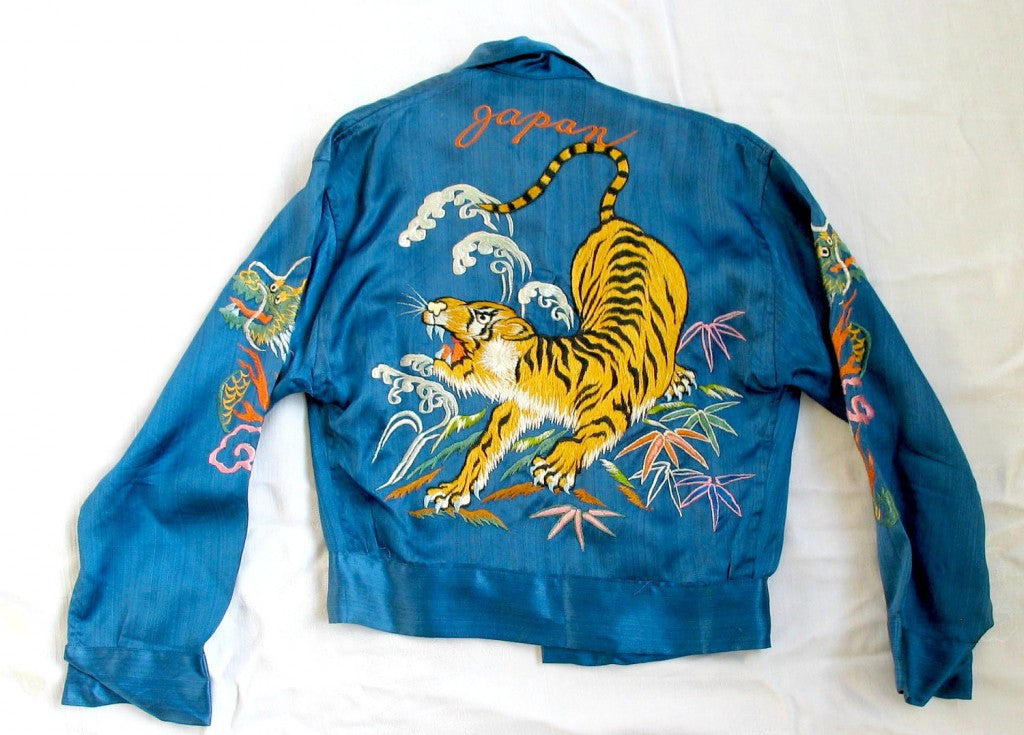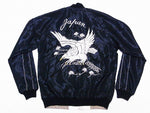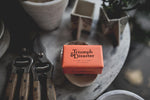Following on from last week's brief history of Tokyo's Toyo Enterprises Co. it's now time to look at one very famous item to which they have been connected since the beginning - The Japan Souvenir Jacket, also known as the Suka Jacket or 'Sukajan' in Japan. The origins of this iconic piece of clothing can be traced back to the end of WW2 and the military occupation by the US Military. It was, quite literally, a souvenir of time spent in the country...

In the midst of the post war chaos, the streets of Ginza became flooded with small shops and street stalls selling traditional Japanese items such as kimonos to American officers and GI's. As demand for such souvenirs grew, new items were developed to cater specifically to the US Military souvenir market. One of these items was a Jacket with oriental embroidered designs. The historians at Toyo claim that it was an invention created by an employee of Kosho & Co. and that they were the first to produce this style of jacket. However, it's more likely that small local Tailors first began adding embroidery to jackets for soldiers on request, and that Kosho & Co. (Toyo Enterprises) were then the first to produce the garments on a larger production scale.

The jackets were made to replicate American styles, such as the military dress jacket, bowling shirt and, most commonly, the Baseball Jacket style. In the beginning, some were manufactured with recycled parachute silk but, due to the scarcity of silk at the time, Acetate was mainly used in production as a substitution. The jackets were brightly coloured, often with contrasting sleeves and embroidered with oriental symbols such as Eagles,Tigers, Mount Fuji and Dragons. Some were personalised with the serviceman's own designs, even depicting detailed maps of military campaigns and images of war, which could be offensive in certain locations. Thankfully, most jackets were reversible. The reasons for this aren't clear but, as the inside is often of a much brighter colour, it may be a military influence inspired by the reversible MA-1 Flight Jacket, first issued in 1949, which featured a bright orange lining to make any downed flight crew visible to search parties flying overhead.

As demand grew and word spread, the jackets began to be sold around bases across the country through the Post Exchange (PX: Stores within US army bases), but it was the largest US Naval base nearest to Tokyo that gave the jacket it's common name in Japan. The huge Yokosuka base was home to thousands of US servicemen and the jackets became known locally as 'Sukajan' or 'Sukajyan' with 'Suka' referring to Yokosuka, and 'Jyan' being a word for 'Jumper' in Japanese. Existing payment sheets in the Toyo Enterprises records show that the jackets were labelled as 'Souvenir Jackets' from the first production runs and both names are still in use today for the jackets.


In order to implement production of the jackets, Kosho & Co. enlisted craftsmen from the cities of Kiryu and Ashikaga. These areas are recognised for their silk textiles and Japanese embroidery to this day and Toyo still employ craftsmen and women, known as Nuiko (sewer), who worked for the company in the 1950's and 1960's. So, far from being a replica jacket, they are still manufacturing the real thing to exacting specifications!


With wars in Korea and Vietnam following on from WW2 the souvenir jacket became more widespread and was soon a common site available for sale in areas close to virtually every US military base around the globe - vintage jackets from Alaska, Hawaii, Honolulu, Guam, Greenland and even Gibraltar, amongst others, can all be found - the list is a long one... it's the US Military we're talking about here.
The jackets began to spread in to fashion culture during the 1960's and became associated with rebelliousness. While the Ivy League style of dress became hugely popular in Japan at this time, outside subcultures began wearing the Sukajyan as a statement of non-conformity and defiance. This led the jacket to become associated with gang culture in Japan, and this association still exists today to a certain extent.

While the statement of rebelliousness probably has a whole lot to do with why Mick is wearing one in the image above, we think the jackets go way beyond that. They began for many as a way of taking home a reminder of the place in which they had spent a part of their life; an unfamiliar place and often during a difficult and dangerous time. They are a blend of cultures, an example of highly skilled craft, an historical record and, overall, they are a beautiful and significant garment in the history of fashion....


